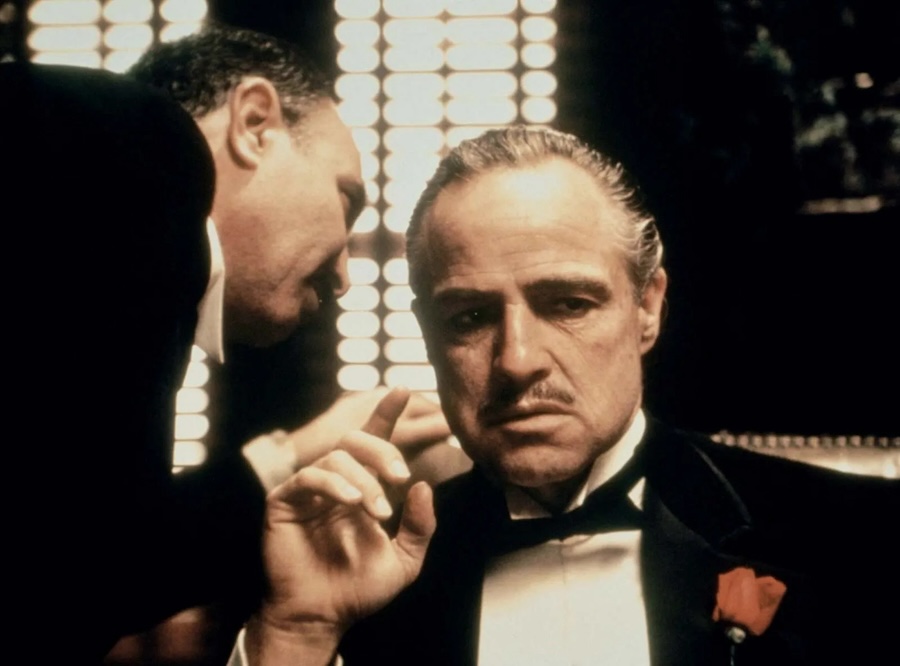

There’s a scene in You’ve Got Mail (1998) where Tom Hanks says, “The Godfather is the sum of all wisdom. The Godfather is the answer to any question”. Every guy loves The Godfather, he explains. There is indeed plenty in this masterpiece to attract anyone. The first spoken words are “I believe in America” and the Godfather saga is very much a story about members of an Italian-American family of organized crime who find their new country full of opportunities. It is also a portrait of an individual’s rise and fall as seen over three films.
Returning from the war
The year is 1945. The Corleone Mafia family is celebrating Don Vito’s (Marlon Brando) daughter Connie’s (Talia Shire) wedding. His youngest son Michael (Al Pacino) has just returned from the war and introduces his girlfriend Kay (Diane Keaton) to the family. He tells her one of the cruel but true stories surrounding his father and the way he conducts business but assures her that he’s not like his dad. Don Vito is having frequent discussions with his oldest son Sonny (James Caan) and the adopted Tom Hagen (Robert Duvall), soon to become the family consigliere, on the future of their business. Sonny and Tom want to get into narcotics because of the financial potential, but Don Vito is hesitant, fearing that it could have damaging political consequences.
“The Turk” Sollozzo (Al Lettieri), a mobster backed by the family’s closest rival, the Tattaglias, soon turns up the temperature by kidnapping Tom, garrotting the Corleone’s most loyal hit man and having assassins shoot Don Vito in the street. However, the patriarch survives the murder attempt and his sons confront the Tattaglias. Michael is slowly drawn into the family business…
Twisted set of family values
With this film, Francis Ford Coppola broke through like few others before him. Together with cinematographer Gordon Willis he sets the tone and style of this family saga already in the first scene. It’s a film where dirty deals are made over whisky and cigarettes in badly lit rooms with heavy, darkly colored furniture. In daytime the visuals are in sepia tone, lending a nostalgic touch to a portrayal of an era that no longer exists.
Mario Puzo’s story has always been about a twisted set of family values; no decent human being wants this kind of organization to thrive, but Puzo, Coppola and the cast emphasize the bonds and camaraderie that exist between the family members and their lieutenants. Without it the Mafia couldn’t function properly. But the filmmakers also show how devastatingly corrupting the membership is; you pay in blood, sooner or later. Michael Corleone starts out as an innocent man, but it doesn’t really take all that much for him to get involved in the family business. The complete, symbolic downfall comes in the end when he assumes leadership of the family and that part of his life becomes figuratively and literally a closed door to Kay.
Marlon Brando enjoyed a comeback with his most memorable character, the careful, gentle, mumbling patriarch whose offers you cannot refuse.
The film has a realistic approach throughout, with locations and characters that have become part of pop culture history. Brando enjoyed a comeback with his most memorable character, the careful, gentle, mumbling patriarch whose offers you cannot refuse; Caan’s Sonny became the ultimate Mob hothead; and Pacino is perfect as the “kid” no one thinks of as an heir to the throne. Nino Rota’s score is also a true classic, in turns beautiful and ominous, firmly grounded in both Italy and America.
The ingenious irony of the baptism scene near the end is so rich it could make you laugh, as Michael renounces Satan in church at the same time as his capos murder his enemies. These are all people governed by a set of rules and principles; if they are broken another guidebook on how to solve the conflict must be followed. What makes this the greatest gangster movie ever made so compelling is the fact that, in spite of the cold calculation, infallible humans always keep events unpredictable.
The Godfather 1972-U.S. 175 min. Color. Directed by Francis Ford Coppola. Screenplay: Francis Ford Coppola, Mario Puzo. Novel: Mario Puzo. Cinematography: Gordon Willis. Music: Nino Rota. Production Design: Dean Tavoularis. Cast: Marlon Brando (Don Vito Corleone), Al Pacino (Michael Corleone), James Caan (Sonny Corleone), Richard Castellano, John Cazale, Diane Keaton, Talia Shire, Robert Duvall, Sterling Hayden, Abe Vigoda.
Trivia: Warren Beatty, Jack Nicholson and Dustin Hoffman were considered for the part of Michael Corleone; Laurence Olivier and Orson Welles for Don Vito. Sergio Leone and Peter Bogdanovich were considered for directing duties. The baby in the baptism scene is Sofia Coppola. In 1981, the film was edited together with its sequel and released as The Godfather: The Complete Epic, 1902-1958. The making of the film was depicted in a limited series, The Offer (2022). Followed by two sequels, starting with The Godfather, Part II (1974).
Oscars: Best Picture, Actor (Brando), Adapted Screenplay. BAFTA: Best Film Music. Golden Globes: Best Motion Picture (Drama), Director, Actor (Brando), Adapted Screenplay, Original Score.
Quote: “What have I ever done to make you treat me so disrespectfully? If you’d come to me in friendship, then this scum that ruined your daughter would be suffering this very day. And if by chance an honest man like yourself should make enemies, then they would become my enemies. And then they would fear you.” (Brando reproaching a visitor)
Last word: “I arranged for the first meeting [between the actors] as an improvisation. I said, ‘I want you to come and be hungry.’ And they came to a restaurant that I had arranged, the back room of the restaurant, just a table that looked like a home. Marlon, I had sit at the head of the table, and to his right I put Al Pacino, and to his left I put Jimmy Caan. I put Bobby Duvall, and I put Johnny Cazale, and I had my sister Talia, who played Connie, serve the food. They had a dinner improvisation together, and after awhile everyone is relating to Marlon as the father, and Jimmy Caan is trying to impress him with jokes, and Al Pacino is trying to impress him by being intense and quiet, and my sister was so frightened – she was serving the food. And after that dinner they were the characters. So one tip I give you is, with improvisations, they really stick if there’s something sensual connected with them, like food or eating or making something with their hands.” (Coppola, 99%)
